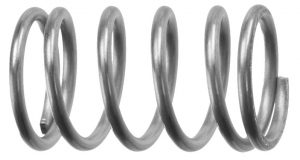
Of all the different types of springs, compression is the most common. They consist of a single piece of coiled metal in a helical shape. They are known as “compression springs” because they apply a compressive force. Even if you’ve used them in the past, though, you might be wondering how compression springs work. This post offers a deeper look at the mechanics of compression springs and how they work.
What Is a Compression Spring?
A compression spring is a helical energy-storing mechanical device (e.g. a spring) that applies an outwards compressive force from both ends. All springs store mechanical energy, which they apply to the object or objects with which they are used. Compression springs simply apply an outwards compressive force. Both sides of a compression spring will apply this outwards compressive force.
There are also extension springs. Extension springs feature a single piece of coiled metal as well, but they use a different design than compression springs. Extension springs are designed to apply an inward force from both ends. In other words, they pull the object or objects with which they are used. Compression springs are different in the sense that they apply an outwards compressive force from both ends. While extension springs pull the object or objects with which they are used, compression springs push the object or objects with which they are used.
How Compression Springs Work
Compression springs work by storing mechanical energy when compressed on both sides. The photo above depicts a compression spring without a load. As you can see, the individual loops don’t touch each other. When a load is applied to a compression spring, however, the loops will touch each other. The presence of a load will push against the compression spring from the sides. In turn, the compression spring will become shorter, with the loops eventually touching each other.
As a compression spring becomes shorter under the presence of a load, it will apply an outwards force from both ends. This force will act against the object or objects by pushing them. Unlike compression springs, extension springs become longer under the presence of a load. They create a pulling force as the individual loops attempt to pull themselves together.
In Conclusion
Compression springs are characterized by their compressive force. They create a compressive force from both ends, which pushes against and compresses the object or objects with which they are used.
